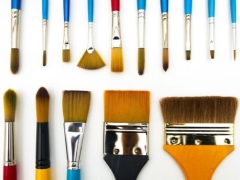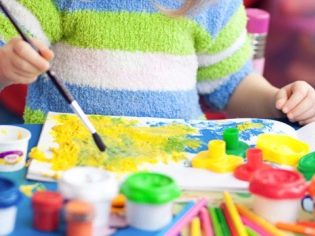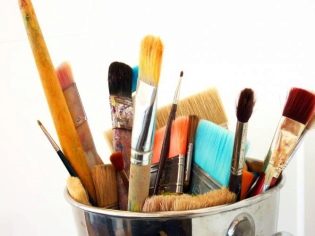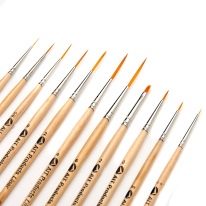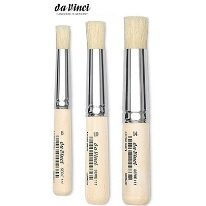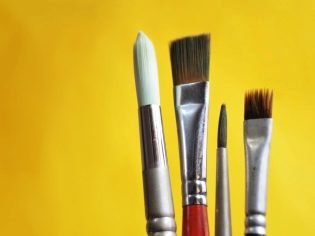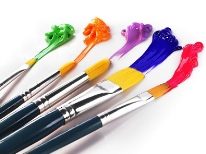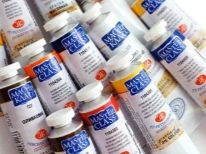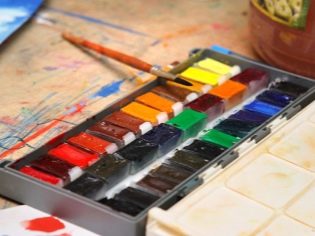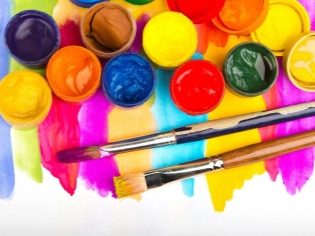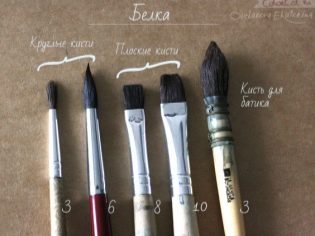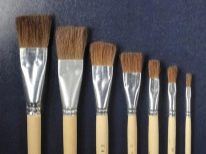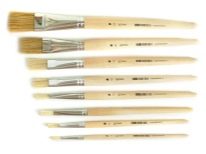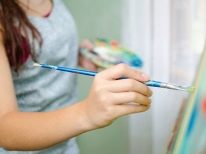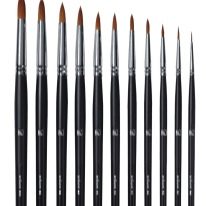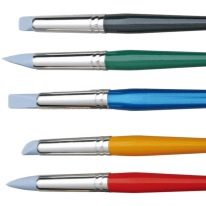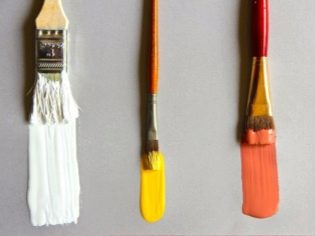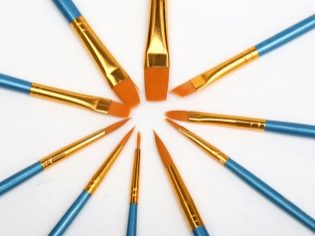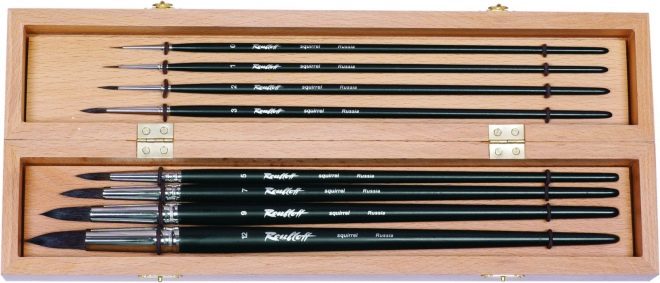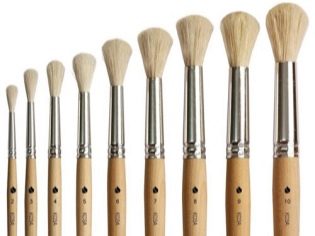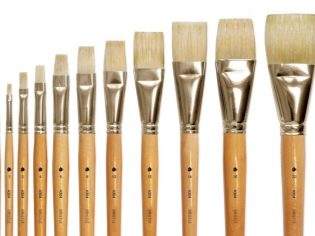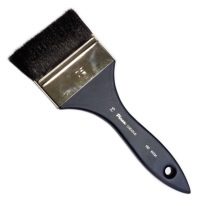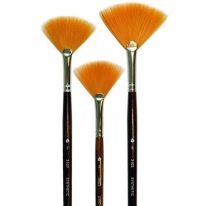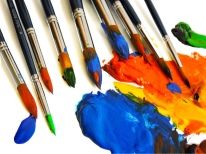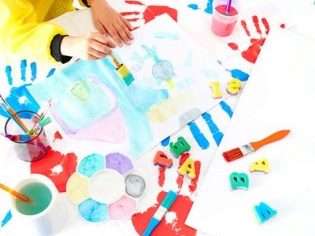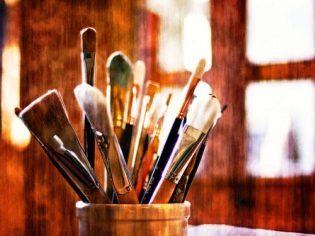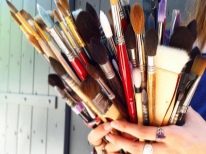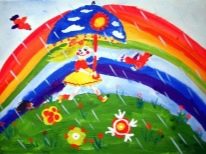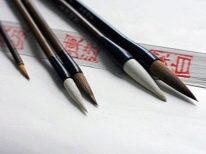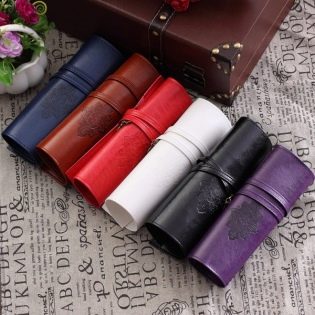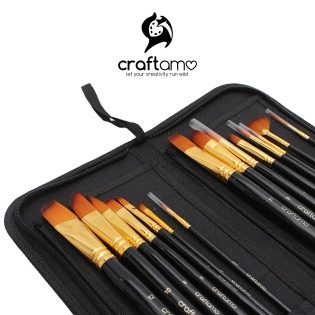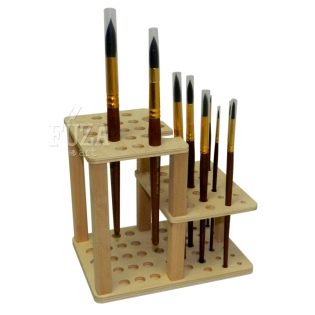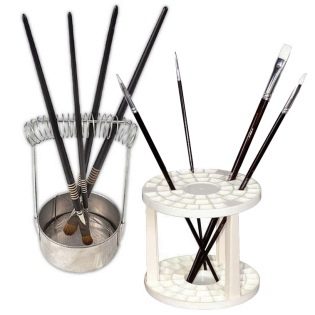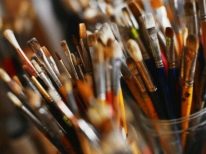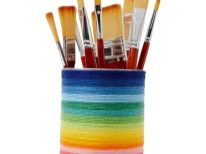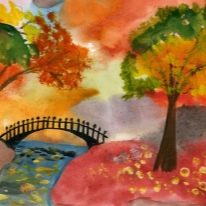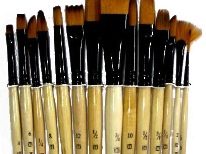Choose the right brush to paint.
Drawing is a rather interesting and fascinating hobby, but if you want to achieve really serious success in it, you cannot ignore any details.
For children's creativity, parents usually pick paints in the first place, but brushes have a great influence on the quality of the realization of creative ideas.
Types and their purpose
The brushes are very different, but the child’s professional models are unlikely to be needed at the training stage. It is worth paying attention to art brushes of a relatively small size - such ones are sold in any store for creative goods. All parts of the brush are of great importance, but the characteristics of the hair beam, by means of which the paint is applied to the painted surface, are of fundamental importance.
Size and shape are the most important, because small brushes make it much easier to draw fine details, and large ones are better suited for tinting large areas.
The stencil brush is distinguished even by such details as no sharp endings in hairs - they are flat and blunt, so staining figures through a stencil is faster and more uniform. For direct application of paint on a drawing, sometimes even sponges are used by analogy with brushes.
An important role is given to the choice of a particular material for the hair bundle - the convenience of working with a specific type of paint, as well as the durability of the product, depends on it. For serious artistic needs, it is better to purchase not one brush, or even a couple, but a whole set.
The brush base may seem primitive, but it also depends on how good this tool is. It must securely interconnect the handle and the hair bundle - the life of the brush depends on it. The seam on the surface of the cap can make the drawing process less convenient, so it is better that it was not.
Even the handle has certain requirements. Firstly, its surface should be smooth - This will allow you not to rub or scratch your hand, even with a huge amount of time devoted to your favorite activity. In addition, the length of the handle is chosen in such a way as to keep the tool in hand was most convenient for its future owner.
What colors are used for?
Different parameters of the hair bundle can be chosen at your own discretion, however, professional artists have long ago developed general recommendations for choosing a brush for each type of paint, thanks to which the palette is better disclosed and details are drawn more clearly.
For example, for oil paints they prefer brushes made from natural pig bristle, capable of absorbing paint. Wool mongoose is also acceptable, except for the toughest of its varieties.
In our country, badger hair is often used as a material. Synthetics is traditionally considered to be a lower-quality substitute for natural raw materials, but a nylon-based brush is one of the rare exceptions to the rules, allowing you to paint in oils without loss of quality.
For water-based paints, the selection of a brush will be simpler, but even here you need to take into account some features. For example, squirrel wool is great for painting with watercolors, and synthetics are not suitable (but it is considered to be the ideal choice when drawing with acrylic paints).
Badger brushes are often recommended for gouache.In general, Russian children most often paint with brushes from squirrels, ponies, pigs, or the omnipresent synthetics.
Manufacturing material
Materials differ in paint absorption and hardness, which can not but affect the final result. Today, there are at least a dozen different materials, and almost every variety has its advantages:
- The most versatile option is the brush from the column, which is widely used by professionals in their field, but this product is rarely bought for children - it costs too much.
- Squirrel wool - the best option for painting with watercolors, and therefore is one of the leaders in the field of children's creativity.
- A pony is another animal that gives inexpensive wool that is well suited for drawing. In general, this material is also quite versatile, but compared to the column it is somewhat inferior in quality.
- For oil paint and did not come up with anything better than pork bristles.
- Badger wool is considered a good option for almost all types of paint, provided a fairly liquid consistency.
- Sable wool is quite versatile and suitable for all types of paints, but it is not used for drawing trifles, and such a tool is very expensive.
- Artificial materials are not very popular among professionals and are used to a greater extent for acrylic-based paints, but nylon brushes are out of this row because they allow you to paint with oil.
- Unusual options, such as rubber or silicone brushes, can have a completely new, unlikely effect that is actively used by modern artists, but can only prevent the child from learning to draw.
Dimensions
If parents are going to buy a small child, who takes only the first steps in drawing, with just one brush, it is better to stop at the average form and size of the variant from universal material, such as pony wool.
However, for serious painting you need brushes with different sizes. When composing your own set, you need to remember that you will have to paint both small details and large monochromatic ones, therefore at least one large and one small brush should be included in the minimum set.
Serious drawing teachers usually tell their students right away what tools they should get in order to achieve the expected result. Brushes, they are usually called numbers - for example, "round number 3". Theoretically, this means that you need any brush with a rounded hair bundle with a diameter of 3 millimeters, unless the teacher called a specific name along with the brand.
In the case when the shape of the brush is different from that for which the concept of diameter is appropriate, the number most often indicates the width of the hair bundle.
It should be borne in mind that the numbering is actively used not only in colloquial speech of people close to painting, but also by the producers of brushes, and this is where the trick lies. Although it is easy to measure the number of millimeters, measurement standards may differ in different collections of the same manufacturer.
Forms
The skill of the artist is not to paint the whole world around with the same brush, but to be able to choose the most suitable tool for the transfer of each individual object. This is another reason why in order to achieve success in painting you need not one brush, but a whole set.
Professional artists use the main forms of the hair bundle as follows:
- Round brush - the most common option that many parents get for their children. Such a tool is optimal for painting small details in bright color - for the so-called “point” pattern. For the gouache painting technique, such a tool can be safely considered as the main one.
- Flat brushes differ in a slightly flattened shape of the hair bundle, due to which they resemble a tongue. This arrangement of the bristles makes the whole bunch more elastic, simplifying long-lasting tangential movements, so this variety is also used quite often - for example, for painting large objects of the picture.
- Brushes called "fleyts" are also very thin, but at the same time they are much wider, somewhat reminiscent of a comb and paint brush. Their use is limited to large-scale painting, they paint mainly using watercolors and gouaches.
- Font and linear brushes are distinguished by an extremely small area of the hair bundle, reduced to the size of a small round point, and the difference between them lies in the fact that the first bristle variety is much longer. This design helps draw thin lines and write out exquisite patterns, and is also best suited for learning calligraphy.
- Fan brushes could be attributed to flat, if not for one “but”: their bristles are arranged in the form of a fan, that is, the common end of the hair bundle does not look like a straight line, but as roundness, with which the canvas will be guaranteed to touch the center, and the flanks - only with a stronger press. This trick is used by those artists who seek to reduce the contrast between the details of the picture and provide a smoother transition of colors.
Other characteristics
Among other small characteristics that affect the final result, first of all it is necessary to highlight the hardness.
Prefer better softer materialsSince elastic bristles feel better the smallest changes in the position of the hand and allow you to draw the smallest details.
Strong bristles with a strong pressure can even slightly spoil the paper on which the drawing will appear, and although some modern artists use this as another artistic device, children are unlikely to need this feature.
Since we are talking about children's creativity, you should not ignore the strength of the product: a poor-quality product can quickly break in half, and the bristles can easily pull out of the base. Children's tools should be ready to make tests of this kind, or at least be cheap enough so that their potential replacement does not look like a problem for the parent wallet.
Which is better to choose?
If the child has already achieved relative success in drawing, it is better to entrust the choice of professional tools to the child himself, because only he knows what he is in need of.
But most parents, buying brushes, do it for children who still can not draw, so the choice must be made independently. Given that adults themselves often have no direct relation to painting, the task only becomes more complicated.
The minimum set for drawing should consist of at least two brushes, one of which will be small, for drawing contours and small details, and the other - large, for drawing surfaces.
If there are only two brushes, then it is better to select the material with the same, ideally - universal, suitable for different paints. In the case of teaching children, the ideal “candidate” is the pony's coat. However, all these considerations are relevant only if the kid takes drawing lessons as part of a comprehensive school program, for any more serious courses a larger set will be needed.
The choice of material here will also depend on the type of paint, and on the type of the basis for the drawings, so special brushes may be better for painting on canvas - not like painting on fabric. When choosing brushes for extra classes question about specific models better to ask the teacher.
Recently, the art of calligraphy has become a fashion trend, which even children are taught in our country today.Here, of course, the choice of brushes is a bit simpler: for them, the main factor of choice is the minimum size of the bundle with a high density of bristles and their sufficient softness.
Useful stuff
Most people think that there is enough paint to paint, a brush, an album and a cup with water to rinse the bristles. Professionals from the world of art will be able to name several dozens of different items that are not strictly required to create a masterpiece, but can somewhat simplify and make the process of creation more pleasant.
For example, for children's brushes a special case or case could be a very useful addition. He will save the tool itself from breakage, excessive beam rags and dirt, and the inside of the bag and the things in it from paint if the child forgets to wash it away.
If there are quite a lot of brushes in the baby’s arsenal, it makes sense to donate packaging for the whole set - such pencil cases will allow the kid to quickly find the brushes in the bag.
Do not get dirty in the process of drawing the table will help a special stand for brushes. It allows you to keep on the bristles correctly mixed color, which is not yet needed, and at the same time not to soil them all around.
When drawing with acrylic paints, it is very convenient to use a sistema brush, when using which the brushes will always be in a state of suspension - so the pile will not touch the bottom and will not deteriorate.
Tips and tricks
You can endlessly choose the highest quality brush, and still with the wrong attitude towards yourself, it will quickly become unusable. Caring for brushes is a simple task, it can significantly extend the life of the product.
Firstly, Keep the brush should be very careful - in a dry and inaccessible to pests like moth place.
You should never put the tool into the container with the beam down, regardless of whether it is stored like this in the intervals between drawing sessions, or simply waiting for its time in the water while the artist draws something else. This attitude leads to a violation of the shape of the beam, straightening it later will be very problematic. Naturally, it is also impossible to strongly press the product against the walls or the bottom of the container during rinsing.
Be sure to wash the brush from the paint after the painting has been completed, otherwise the dye will dry out and cause the loss of elasticity of the bristles, as well as contribute to their loss.
If watercolor and gouache are normally washed out with plain water, then after working with oil and acrylic, you will also have to use a special solvent. However, after it, it is also necessary to rinse the bundle under tap water, since the solvent represents a great danger to the glue holding the bundle together, and if it dissolves, the brush tip will quickly thin out.
Famous manufacturers and reviews
Trying to identify the best brushes from the words of the artists themselves is quite problematic - they often cannot agree among themselves on which manufacturer is better, since each has its own needs. At the same time, there are several well-known foreign manufacturers who produce very good products - these are brands. Da vinci and Raphael, from the Russian success Colos and Rubleff.
Many artists do not hesitate to say that for the wide disposable strokes almost building tools are used. At the same time, the described stamps orient themselves mainly to drawing, and you can take any brushes for calligraphy, since the original, Japanese ones, are unlikely to be found in our country.
For children's creativity, unknown brands are often chosen, according to the principle “if only it was inexpensive, and it was at least relatively convenient.” In its own way, this approach is correct, but only until the child begins to make progress in his work. Then he may need to give some transitional option - such as a set from Ikea of 6 tools, which is definitely not professional, but still has a certain quality and is made specifically for kids.
About what brushes are needed for drawing and how to use them, see the next video.
